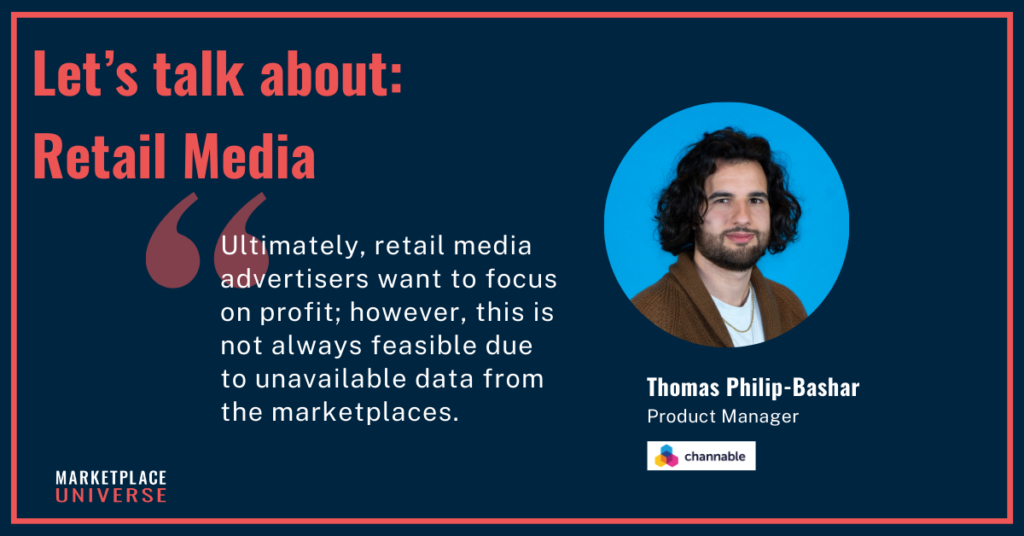
Retail Media is the fastest growing advertising channel worldwide at the moment – and online-marketplaces are profiting strongly from this new trend. Marketplace Universe spoke with Retail Media expert Thomas Philip-Bashar, Product manager at eCommerce solution provider Channable, about current trends in this highly dynamic field.
Thomas, why is Retail Media advertising so attractive for marketeers at the moment, especially on marketplaces?
Thomas Philip-Bashar: Retail Media is a new type of technology, but it’s not a new type of advertising style. If you think about how a high street shop would work, you will see almost the same concepts and behaviors. For example, having products on shelves at eye level better placed than competitors (Sponsored Products and Brands) or having advertising boards with eye-catching infographics (Sponsored Display). So while the behavior of how the consumers consume has switched to online, the marketing has not changed. It has merely adapted to the new digital store. So the reason the type of advertising is so attractive is because online retail media marketplaces are replicating the same old norms of marketing that consumers are used to when consuming on the high street.
Amazon Advertising is the clear forerunner in terms of Retail Media. Where do the other marketplace stand? Who is the best runner-up in your opinion?
Thomas: This depends completely on the regional market. For instance Walmart would be the closest to Amazon in the US. However, in Europe as a whole, second to Amazon would be the likes of eBay and Zalando. But in specific regions such as the Netherlands you will see that Bol is far ahead of Amazon. In terms of types of advertisement, most if not all marketplaces follow the route of the standard industry ad practice. Sponsored Products as the basic ad format and then they supplement that with Sponsored Brands/Display. A new type of ad is referred to as Off-site. These are ads on third party websites or domains. For example Amazon now allows for advertising on Prime and also Twitch. But in essence there is no best runner up when it comes to offering different or innovating ad types, only a runner up in terms of market share.
What Retail media Advertisers want
What trends are you currently observing in the retail media space on online marketplaces?
Thomas: From an advertiser point of view, the trends we are seeing revolve around campaign set up and optimisation. Advertisers want to be able to set up campaigns for their products in bulk whilst minimizing the campaign count. After this there is a requirement to be able to streamline the performance review process. Advertisers want to achieve this via automation or campaign/product level insights that trigger or inform alterations to campaigns thus optimizing performance. More commonly we are also seeing the use of dayparting within campaign set ups to increase the efficiency of a campaigns budget.
What role does AI and machine learning play in optimizing retail media campaigns on online marketplaces?
Thomas: Currently machine learning is quite prevalent in the optimisation process of campaigns. Features such as Amazon recommendations and bidding changes are classic examples of this. The more the optimization process is accurately optimized by machine learning the more time will be saved on performance reviews. That is a key value to online advertisers and agencies. AI is something that I see becoming more influential over the next few years for keyword suggestions and campaign creations.
Key Retail Media KPI’s focus on Profitability
What are the key performance indicators (KPIs) that brands should focus on when evaluating the success of their retail media efforts?
Thomas: Advertising Cost of Sales (ACoS) and Total Advertising Cost of Sales (TACoS) are two metrics our clients focus on most. However, it differs between advertisers and agencies. Some also focus on Ad spend, Clicks to Orders ratio or Click Through Rate (CTR). The values on these metrics vary between advertisers but some metrics have an industry average. For instance, an ACoS of approximately 30% or Return On Ad Spend (ROAS) by general rule of thumb having $4 in revenue for every $1 spent. Ultimately, advertisers want to focus on profit however, this is not always feasible due to unavailable/missing cost data from marketplaces. Therefore, ROAS and ACoS are really important metrics when it comes to monitoring and measuring campaign profit.
Can you discuss any innovative or emerging retail media formats that brands should be aware of?
Thomas: As mentioned previously I wouldn’t say there are any new inventions for advertising types that throw the cat amongst the pigeons when it comes to breaking away from the standard sponsored products, brands or display. However, there are cool things happening in supporting the creation of sponsored brands and display creatives. For example Amazon is now offering an AI image generator. It utilizes machine learning to create images and videos that are generated from text inputs within seconds. This can significantly reduce time spent on creative production and improve conversion rates.
Thanks for your insights!